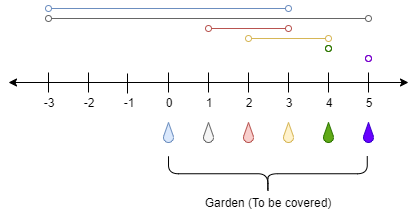1. Minimum Number of Taps to Open to Water a Garden
There is a one-dimensional garden on the x-axis. The garden starts at the point 0 and ends at the point n. (i.e The length of the garden is n).
There are n + 1 taps located at points [0, 1, ..., n] in the garden.
Given an integer n and an integer array ranges of length n + 1 where ranges[i] (0-indexed) means the i-th tap can water the area [i - ranges[i], i + ranges[i]] if it was open.
Return the minimum number of taps that should be open to water the whole garden, If the garden cannot be watered return -1.
Example 1:

Input: n = 5, ranges = [3,4,1,1,0,0] Output: 1 Explanation: The tap at point 0 can cover the interval [-3,3] The tap at point 1 can cover the interval [-3,5] The tap at point 2 can cover the interval [1,3] The tap at point 3 can cover the interval [2,4] The tap at point 4 can cover the interval [4,4] The tap at point 5 can cover the interval [5,5] Opening Only the second tap will water the whole garden [0,5]
Example 2:
Input: n = 3, ranges = [0,0,0,0] Output: -1 Explanation: Even if you activate all the four taps you cannot water the whole garden.
Constraints:
- 1 <= n <= 104
- ranges.length == n + 1
- 0 <= ranges[i] <= 100
2. Counting Ways to Write Number as Sum of Consecutive Integers
Given an integer n, return the number of ways you can write n as the sum of consecutive positive integers.
Example 1:
Input: n = 5 Output: 2 Explanation: 5 = 2 + 3
Example 2:
Input: n = 9 Output: 3 Explanation: 9 = 4 + 5 = 2 + 3 + 4
Example 3:
Input: n = 15 Output: 4 Explanation: 15 = 8 + 7 = 4 + 5 + 6 = 1 + 2 + 3 + 4 + 5
Constraints:
- 1 <= n <= 109
3. "Finding Minimum Number of Unique Integers After Removing K Elements"
Given an array of integers arr and an integer k. Find the least number of unique integers after removing exactly k elements.
Example 1:
Input: arr = [5,5,4], k = 1 Output: 1 Explanation: Remove the single 4, only 5 is left.
Example 2:
Input: arr = [4,3,1,1,3,3,2], k = 3 Output: 2 Explanation: Remove 4, 2 and either one of the two 1s or three 3s. 1 and 3 will be left.
Constraints:
- 1 <= arr.length <= 10^5
- 1 <= arr[i] <= 10^9
- 0 <= k <= arr.length


